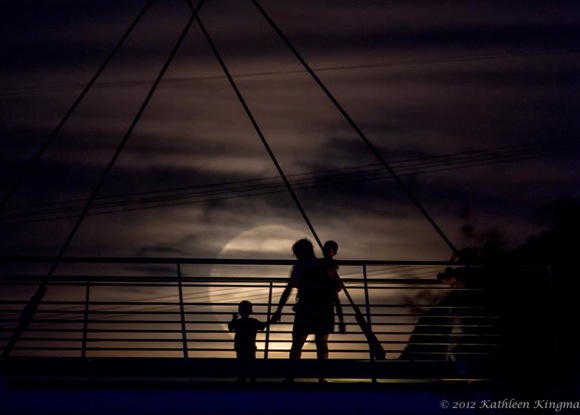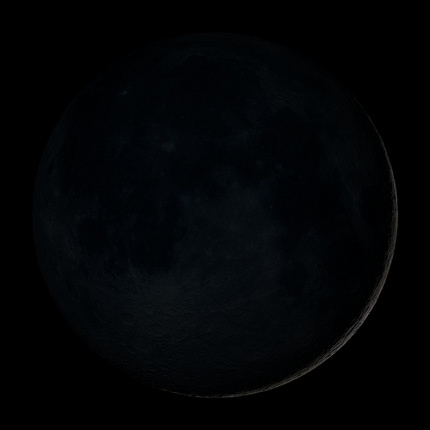
The full Earth as viewed from the near side of the moon at instant of new moon (2014 January 1 at 11:14Universal Time).
Photo above: Extremely thin young moon, coming on the heels of new ....
January 1, 2014 presents the first of two supermoons to occur in a single calendar month. The second supermoon will come on January 30, 2014. We won’t have a single calendar month with two supermoons again until January 2018.
What, you say? Supermoon? But the moon isn’t anywhere near full! That’s right. These aren’t full supermoons. They are new supermoons; the moon is at the new phase for both the January 1 and January 30 supermoon. Follow the links below to learn more about the supermoons of 2014.
What is a supermoon? The term supermoon didn’t come from astronomy. We used to call these moons perigee new moons or perigee full moons. Perigee means “near Earth.” An astrologer, Richard Nolle, is credited with coining the term supermoon. He defines them as:
. . . a new or full moon which occurs with the moon at or near (within 90% of) its closest approach to Earth.
By this definition, a new moon or full moon has to come within 361,863 kilometers (224,851 miles) of our planet, as measured from the centers of the moon and Earth, in order to be a supermoon.
That’s a very generous definition, and it’s why supermoons are common. The year 2014 gives us a total of five supermoons: two January new moons, and the full moons of July, August and September.
What time is today’s new moon? How close is today’s perigee? Today’s moon is new at 11:14 UTC.
Today’s perigee happens around 21:00 UTC and brings the moon second-closest for this entire year at 221,782 miles (356,923 km).
How do I translate Universal Time to my time?

Josh Blash in Rye, New Hampshire said he was photobombed by a seagull while taking this beautiful sunset photo of a full moon rising over the ocean. Photo taken October 18, 2013.

Around each new moon (left) and full moon (right) – when the sun, Earth, and moon are located more or less on a line in space – the range between high and low tides is greatest. These are called spring tides. Image via physicalgeography.net
Spring tides accompany January 2014′s supermoons. Will the tides be larger than usual at the January 1 and 30 new moons? Yes, all new moons (and full moons) combine with the sun to create larger-than-usual tides, but perigee new moons (or perigee full moons) elevate the tides even more.
Each month, on the day of the new moon, the Earth, moon and sun are aligned, with the moon in between. This line-up creates wide-ranging tides, known as spring tides. High spring tides climb up especially high, and on the same day low tides plunge especially low.
The January 1 and 30 extra-close new moons will accentuate the spring tide, giving rise to what’s called a perigean spring tide. If you live along an ocean coastline, watch for high tides caused by the two January 2014 new moons – or supermoons.
Will these high tides cause flooding? Probably not, unless a strong weather system accompanies the perigean spring tide. Still, keep an eye on the weather, because storms do have a large potential to accentuate perigean spring tides.
Can I see the January 1 or January 30 supermoon? Don’t expect to see the new moon on January 1 or January 30. At the vicinity of new moon, the moon hides in the glare of the sun all day long, rising with the sun at sunrise and setting with the sun at sunset. On the other hand, if you were on the moon looking at Earth, you’d see a full Earth.
Possible exception to what I just said: People in far-western North America or islands in the Pacific might be able to spot an extremely-thin young moon with binoculars after sunset on January 1, 2014. Why western North America? That’s the last largely populated time zone before January 2 dawns at the International Date Line. By the time the sun sets there, the moon will have had time to pull some distance away from the sun on the sky’s dome … so careful observers might spot it! Use binoculars, and scan above the place the sun set.

The closest supermoon of 2013 was the full moon on June 23. Photo of June 23, 2013 supermoon by EarthSky Facebook friend Kathleen Kingma. Click for more awesome photos of June 23, 2013 supermoon.
What is the closest supermoon of 2014? As we said above, the year 2014 will have five supermoons: two January new moons, and the full moons of July, August and September.
The full moon on August 10, 2014, is the closest supermoon of the year (356,896 kilometers or 221,765 miles).
However, the new moons on January 1 and January 30 will not be all that far behind, featuring the year’s second-closest and third-closest supermoons, respectively. On January 1, the moon turns new approximately 10 hours before reaching lunar perigee – the moon’s closest point to Earth in its orbit. On January 30, the moon turns new nearly 12 hours after reaching lunar perigee.
Click here for a perigee and apogee calculator
Farthest full moon of 2014 is in January, too. Incidentally, the moon turns full this month on January 16, 2014, only a few hours after swinging to lunar apogee – the moon’s most distant point from Earth for the month (406,532 kilometers or 252,607 miles).
So two weeks after the year’s nearest new moon on January 1, it’ll be the year’s farthest and smallest full moon on January 16, 2014. People are calling this sort of moon a micro moon.
Afterwards, it’ll be the year’s second-closest new moon on January 30.
Bottom line: What a super way to start the New Year, with the close alignment of the new moon and perigee ushering a supermoon on January 1, 2014, and yet another supermoon on January 30, 2014! Wow!
